Network Upgrade Proposal: Wiakato District Educational Institute
VerifiedAdded on 2022/11/23
|26
|4388
|267
Project
AI Summary
This project is a comprehensive network upgrade proposal, disaster recovery, and business continuity plan for the Wiakato District Educational Institute in New Zealand. The proposal addresses the need to upgrade the existing network infrastructure to improve speed, security, and efficiency, and to accommodate the growing number of users. The current network utilizes older switches and a star-wired topology. The proposed solution involves upgrading to fiber optic cables and implementing Cisco SAFE architecture and GPON technology. The document includes a detailed network analysis, justification for the chosen technologies, work scope, assumptions, and risk assessment. It also outlines a disaster recovery plan, including incident indicators, roles, and procedures, as well as a business continuity plan focusing on critical function analysis and emergency response. The project aims to enhance network performance, data security, and operational resilience for the educational institute.
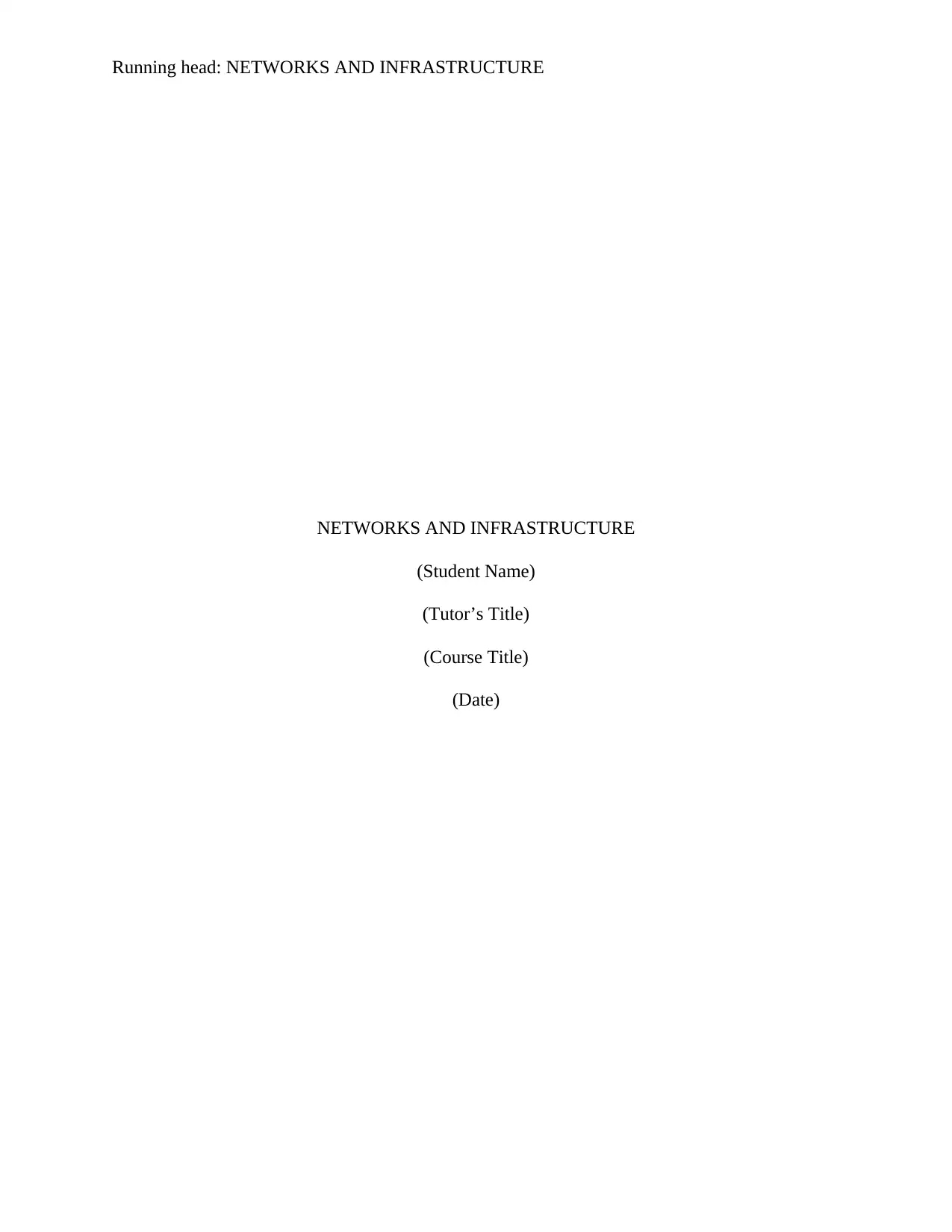
Running head: NETWORKS AND INFRASTRUCTURE
NETWORKS AND INFRASTRUCTURE
(Student Name)
(Tutor’s Title)
(Course Title)
(Date)
NETWORKS AND INFRASTRUCTURE
(Student Name)
(Tutor’s Title)
(Course Title)
(Date)
Paraphrase This Document
Need a fresh take? Get an instant paraphrase of this document with our AI Paraphraser
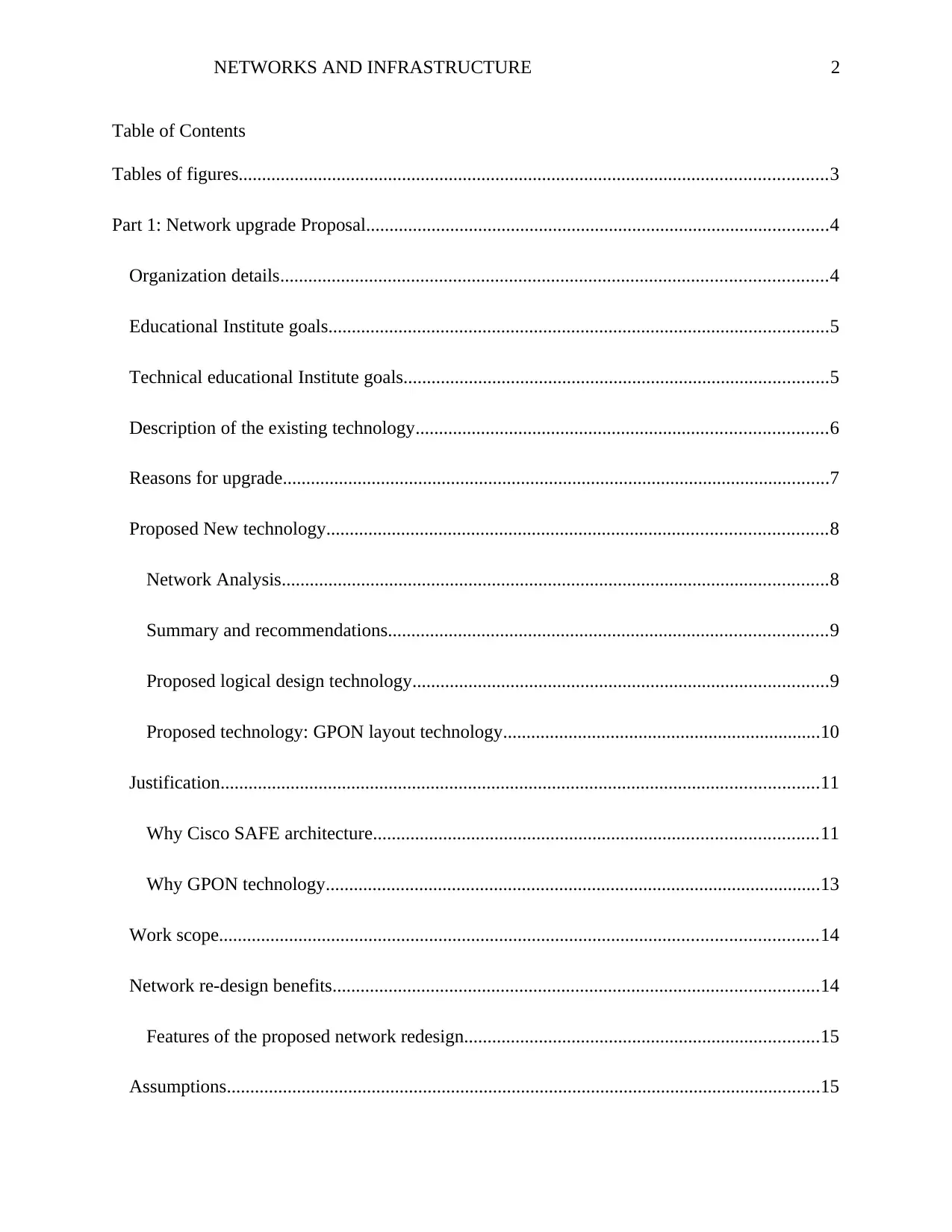
NETWORKS AND INFRASTRUCTURE 2
Table of Contents
Tables of figures..............................................................................................................................3
Part 1: Network upgrade Proposal...................................................................................................4
Organization details.....................................................................................................................4
Educational Institute goals...........................................................................................................5
Technical educational Institute goals...........................................................................................5
Description of the existing technology........................................................................................6
Reasons for upgrade.....................................................................................................................7
Proposed New technology...........................................................................................................8
Network Analysis.....................................................................................................................8
Summary and recommendations..............................................................................................9
Proposed logical design technology.........................................................................................9
Proposed technology: GPON layout technology....................................................................10
Justification................................................................................................................................11
Why Cisco SAFE architecture...............................................................................................11
Why GPON technology..........................................................................................................13
Work scope................................................................................................................................14
Network re-design benefits........................................................................................................14
Features of the proposed network redesign............................................................................15
Assumptions...............................................................................................................................15
Table of Contents
Tables of figures..............................................................................................................................3
Part 1: Network upgrade Proposal...................................................................................................4
Organization details.....................................................................................................................4
Educational Institute goals...........................................................................................................5
Technical educational Institute goals...........................................................................................5
Description of the existing technology........................................................................................6
Reasons for upgrade.....................................................................................................................7
Proposed New technology...........................................................................................................8
Network Analysis.....................................................................................................................8
Summary and recommendations..............................................................................................9
Proposed logical design technology.........................................................................................9
Proposed technology: GPON layout technology....................................................................10
Justification................................................................................................................................11
Why Cisco SAFE architecture...............................................................................................11
Why GPON technology..........................................................................................................13
Work scope................................................................................................................................14
Network re-design benefits........................................................................................................14
Features of the proposed network redesign............................................................................15
Assumptions...............................................................................................................................15
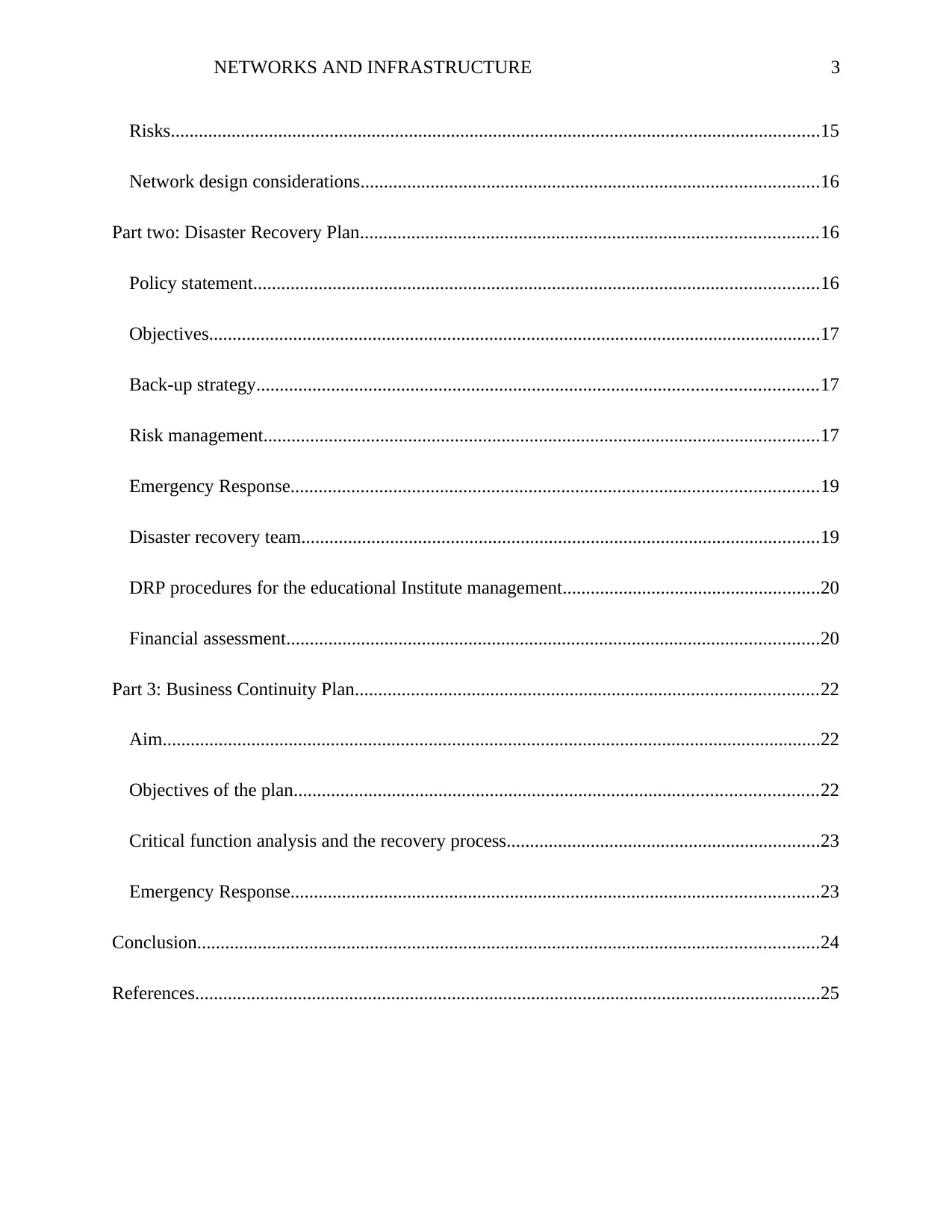
NETWORKS AND INFRASTRUCTURE 3
Risks...........................................................................................................................................15
Network design considerations..................................................................................................16
Part two: Disaster Recovery Plan..................................................................................................16
Policy statement.........................................................................................................................16
Objectives...................................................................................................................................17
Back-up strategy........................................................................................................................17
Risk management.......................................................................................................................17
Emergency Response.................................................................................................................19
Disaster recovery team...............................................................................................................19
DRP procedures for the educational Institute management.......................................................20
Financial assessment..................................................................................................................20
Part 3: Business Continuity Plan...................................................................................................22
Aim.............................................................................................................................................22
Objectives of the plan................................................................................................................22
Critical function analysis and the recovery process...................................................................23
Emergency Response.................................................................................................................23
Conclusion.....................................................................................................................................24
References......................................................................................................................................25
Risks...........................................................................................................................................15
Network design considerations..................................................................................................16
Part two: Disaster Recovery Plan..................................................................................................16
Policy statement.........................................................................................................................16
Objectives...................................................................................................................................17
Back-up strategy........................................................................................................................17
Risk management.......................................................................................................................17
Emergency Response.................................................................................................................19
Disaster recovery team...............................................................................................................19
DRP procedures for the educational Institute management.......................................................20
Financial assessment..................................................................................................................20
Part 3: Business Continuity Plan...................................................................................................22
Aim.............................................................................................................................................22
Objectives of the plan................................................................................................................22
Critical function analysis and the recovery process...................................................................23
Emergency Response.................................................................................................................23
Conclusion.....................................................................................................................................24
References......................................................................................................................................25
⊘ This is a preview!⊘
Do you want full access?
Subscribe today to unlock all pages.

Trusted by 1+ million students worldwide
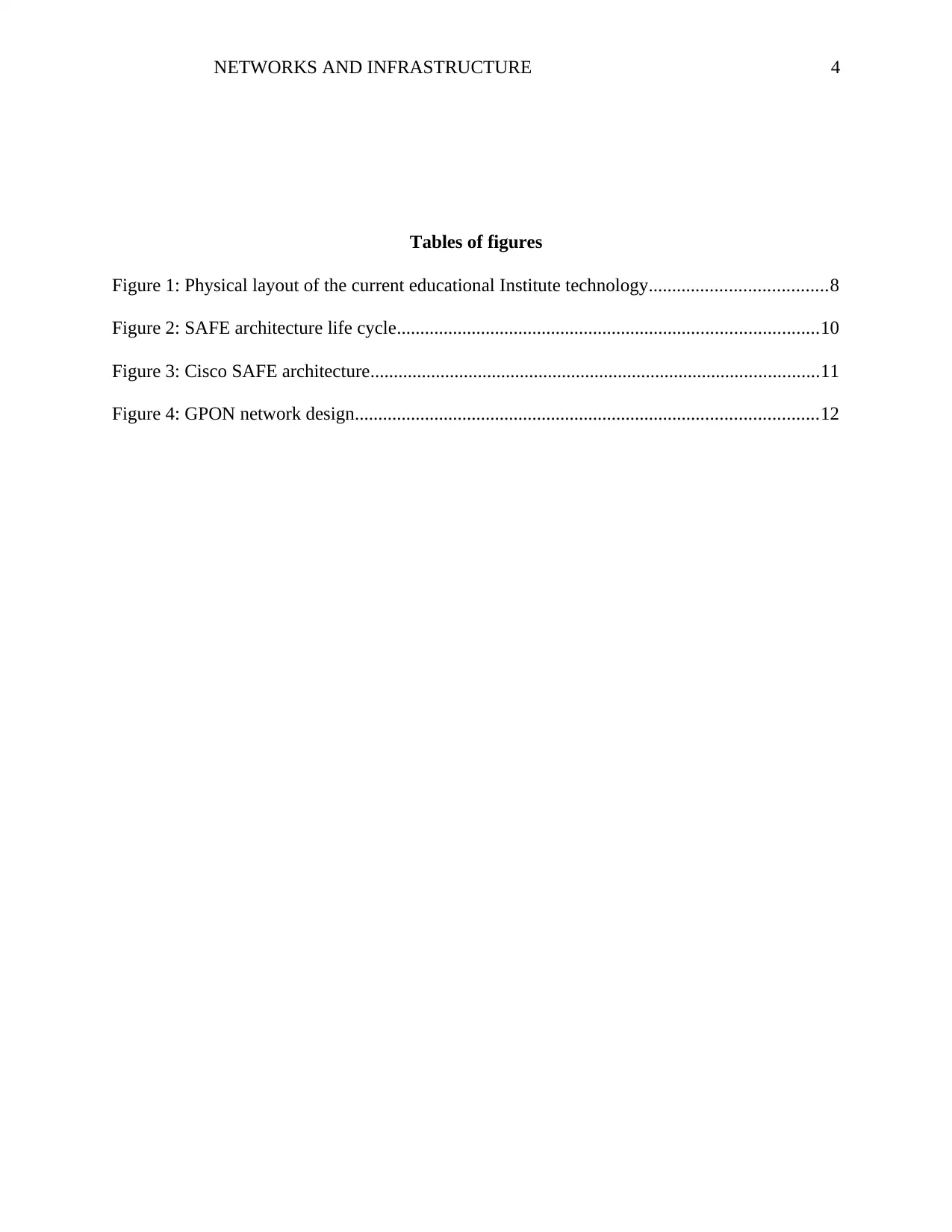
NETWORKS AND INFRASTRUCTURE 4
Tables of figures
Figure 1: Physical layout of the current educational Institute technology......................................8
Figure 2: SAFE architecture life cycle..........................................................................................10
Figure 3: Cisco SAFE architecture................................................................................................11
Figure 4: GPON network design...................................................................................................12
Tables of figures
Figure 1: Physical layout of the current educational Institute technology......................................8
Figure 2: SAFE architecture life cycle..........................................................................................10
Figure 3: Cisco SAFE architecture................................................................................................11
Figure 4: GPON network design...................................................................................................12
Paraphrase This Document
Need a fresh take? Get an instant paraphrase of this document with our AI Paraphraser

NETWORKS AND INFRASTRUCTURE 5
Part 1: Network upgrade Proposal
Organization details
Wiakato District Educational Institute is located in New Zealand. It is an educational
institute with about 1000 users of the network both teaching staff, non-teaching staff, and
students. On daily basis the educational Institute supports over 500 users. The educational
Institute have five remote campuses which are located across New Zealand. Current the main
branch is located in a four floors building. Due to population growth the educational Institute is
currently upgrading to have a fifth floor which will handle the increasing number of students in
the institution. In addition, the educational Institute carries high student records. In addition, the
educational Institute has several workstations but the main one are the customer care desk, staff
room, the educational Institute lab, the finance unit which is also known as the billing office, and
administrative office. The country requires every educational Institute to be compliant with the
current IEEE guidelines and due to this the institution has employed email protection and data
encryption which they view it as a means of protecting the institution sensitive information. The
education institution also handles online classes to their students
Educational Institute goals
Increase educational Institute staff productivity: This will automatically be measured by
the how long an employee takes to deliver a certain target and how many minutes or the
duration it takes serve an online student. The current time that it takes to serve a client is
4 minutes which is a result of the poor network design
Part 1: Network upgrade Proposal
Organization details
Wiakato District Educational Institute is located in New Zealand. It is an educational
institute with about 1000 users of the network both teaching staff, non-teaching staff, and
students. On daily basis the educational Institute supports over 500 users. The educational
Institute have five remote campuses which are located across New Zealand. Current the main
branch is located in a four floors building. Due to population growth the educational Institute is
currently upgrading to have a fifth floor which will handle the increasing number of students in
the institution. In addition, the educational Institute carries high student records. In addition, the
educational Institute has several workstations but the main one are the customer care desk, staff
room, the educational Institute lab, the finance unit which is also known as the billing office, and
administrative office. The country requires every educational Institute to be compliant with the
current IEEE guidelines and due to this the institution has employed email protection and data
encryption which they view it as a means of protecting the institution sensitive information. The
education institution also handles online classes to their students
Educational Institute goals
Increase educational Institute staff productivity: This will automatically be measured by
the how long an employee takes to deliver a certain target and how many minutes or the
duration it takes serve an online student. The current time that it takes to serve a client is
4 minutes which is a result of the poor network design
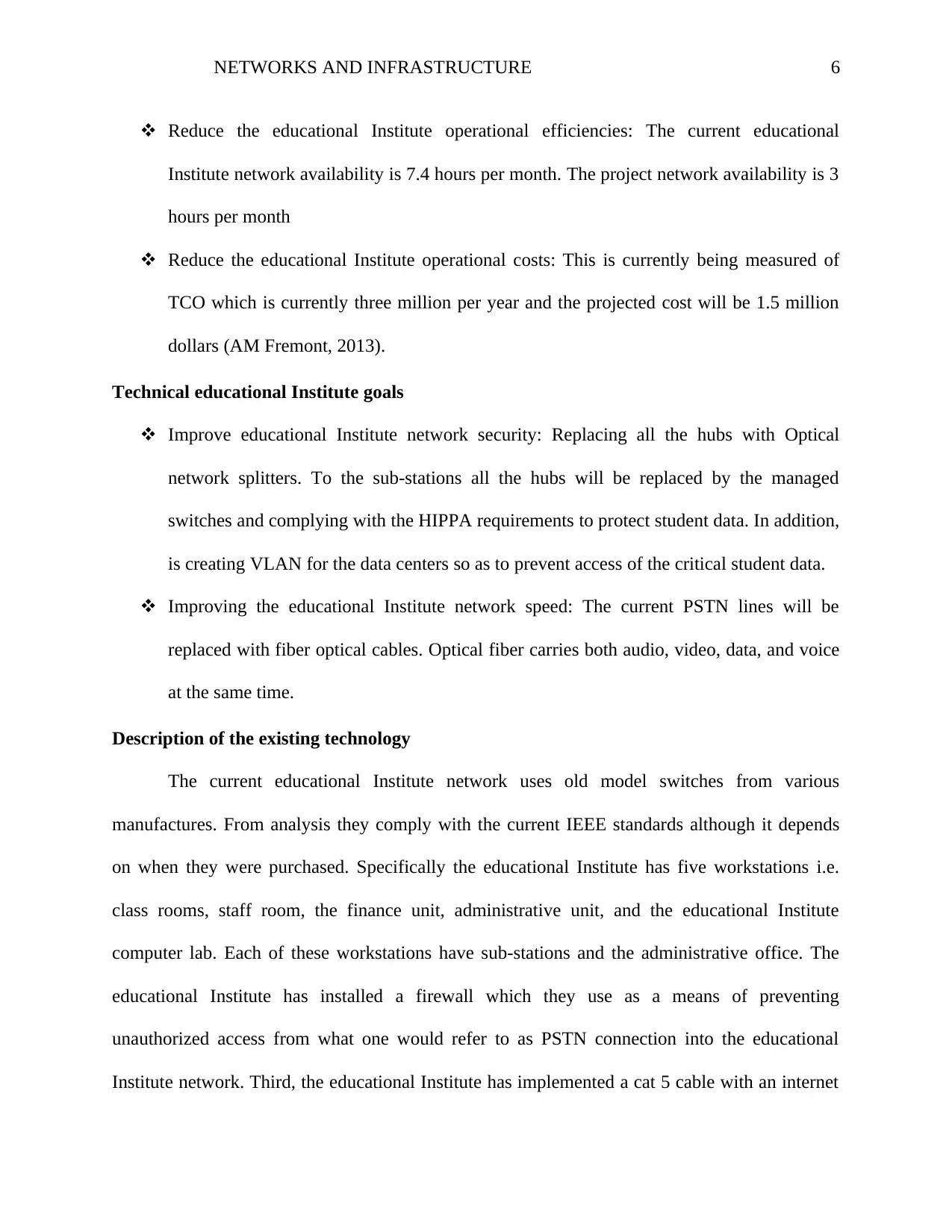
NETWORKS AND INFRASTRUCTURE 6
Reduce the educational Institute operational efficiencies: The current educational
Institute network availability is 7.4 hours per month. The project network availability is 3
hours per month
Reduce the educational Institute operational costs: This is currently being measured of
TCO which is currently three million per year and the projected cost will be 1.5 million
dollars (AM Fremont, 2013).
Technical educational Institute goals
Improve educational Institute network security: Replacing all the hubs with Optical
network splitters. To the sub-stations all the hubs will be replaced by the managed
switches and complying with the HIPPA requirements to protect student data. In addition,
is creating VLAN for the data centers so as to prevent access of the critical student data.
Improving the educational Institute network speed: The current PSTN lines will be
replaced with fiber optical cables. Optical fiber carries both audio, video, data, and voice
at the same time.
Description of the existing technology
The current educational Institute network uses old model switches from various
manufactures. From analysis they comply with the current IEEE standards although it depends
on when they were purchased. Specifically the educational Institute has five workstations i.e.
class rooms, staff room, the finance unit, administrative unit, and the educational Institute
computer lab. Each of these workstations have sub-stations and the administrative office. The
educational Institute has installed a firewall which they use as a means of preventing
unauthorized access from what one would refer to as PSTN connection into the educational
Institute network. Third, the educational Institute has implemented a cat 5 cable with an internet
Reduce the educational Institute operational efficiencies: The current educational
Institute network availability is 7.4 hours per month. The project network availability is 3
hours per month
Reduce the educational Institute operational costs: This is currently being measured of
TCO which is currently three million per year and the projected cost will be 1.5 million
dollars (AM Fremont, 2013).
Technical educational Institute goals
Improve educational Institute network security: Replacing all the hubs with Optical
network splitters. To the sub-stations all the hubs will be replaced by the managed
switches and complying with the HIPPA requirements to protect student data. In addition,
is creating VLAN for the data centers so as to prevent access of the critical student data.
Improving the educational Institute network speed: The current PSTN lines will be
replaced with fiber optical cables. Optical fiber carries both audio, video, data, and voice
at the same time.
Description of the existing technology
The current educational Institute network uses old model switches from various
manufactures. From analysis they comply with the current IEEE standards although it depends
on when they were purchased. Specifically the educational Institute has five workstations i.e.
class rooms, staff room, the finance unit, administrative unit, and the educational Institute
computer lab. Each of these workstations have sub-stations and the administrative office. The
educational Institute has installed a firewall which they use as a means of preventing
unauthorized access from what one would refer to as PSTN connection into the educational
Institute network. Third, the educational Institute has implemented a cat 5 cable with an internet
⊘ This is a preview!⊘
Do you want full access?
Subscribe today to unlock all pages.

Trusted by 1+ million students worldwide
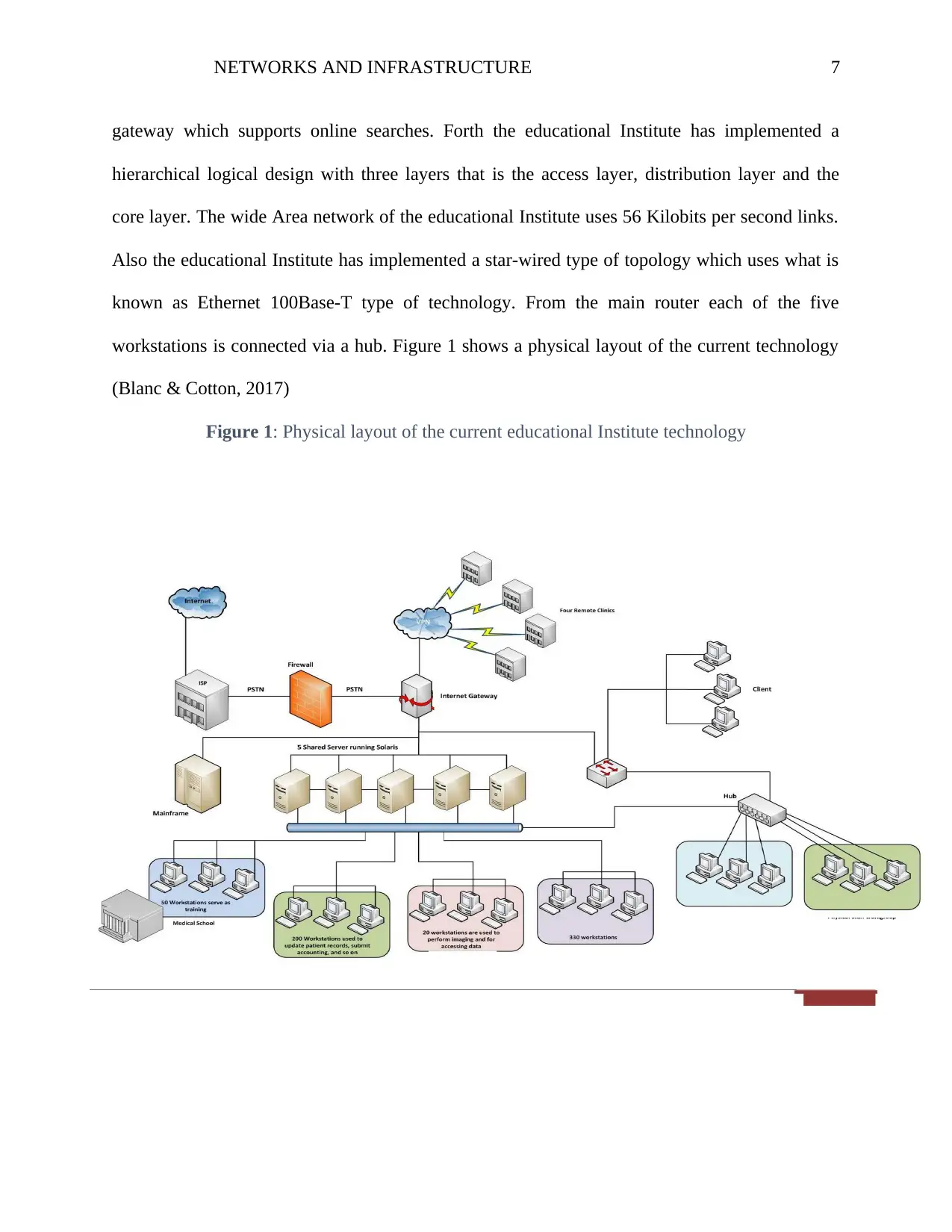
NETWORKS AND INFRASTRUCTURE 7
gateway which supports online searches. Forth the educational Institute has implemented a
hierarchical logical design with three layers that is the access layer, distribution layer and the
core layer. The wide Area network of the educational Institute uses 56 Kilobits per second links.
Also the educational Institute has implemented a star-wired type of topology which uses what is
known as Ethernet 100Base-T type of technology. From the main router each of the five
workstations is connected via a hub. Figure 1 shows a physical layout of the current technology
(Blanc & Cotton, 2017)
Figure 1: Physical layout of the current educational Institute technology
gateway which supports online searches. Forth the educational Institute has implemented a
hierarchical logical design with three layers that is the access layer, distribution layer and the
core layer. The wide Area network of the educational Institute uses 56 Kilobits per second links.
Also the educational Institute has implemented a star-wired type of topology which uses what is
known as Ethernet 100Base-T type of technology. From the main router each of the five
workstations is connected via a hub. Figure 1 shows a physical layout of the current technology
(Blanc & Cotton, 2017)
Figure 1: Physical layout of the current educational Institute technology
Paraphrase This Document
Need a fresh take? Get an instant paraphrase of this document with our AI Paraphraser
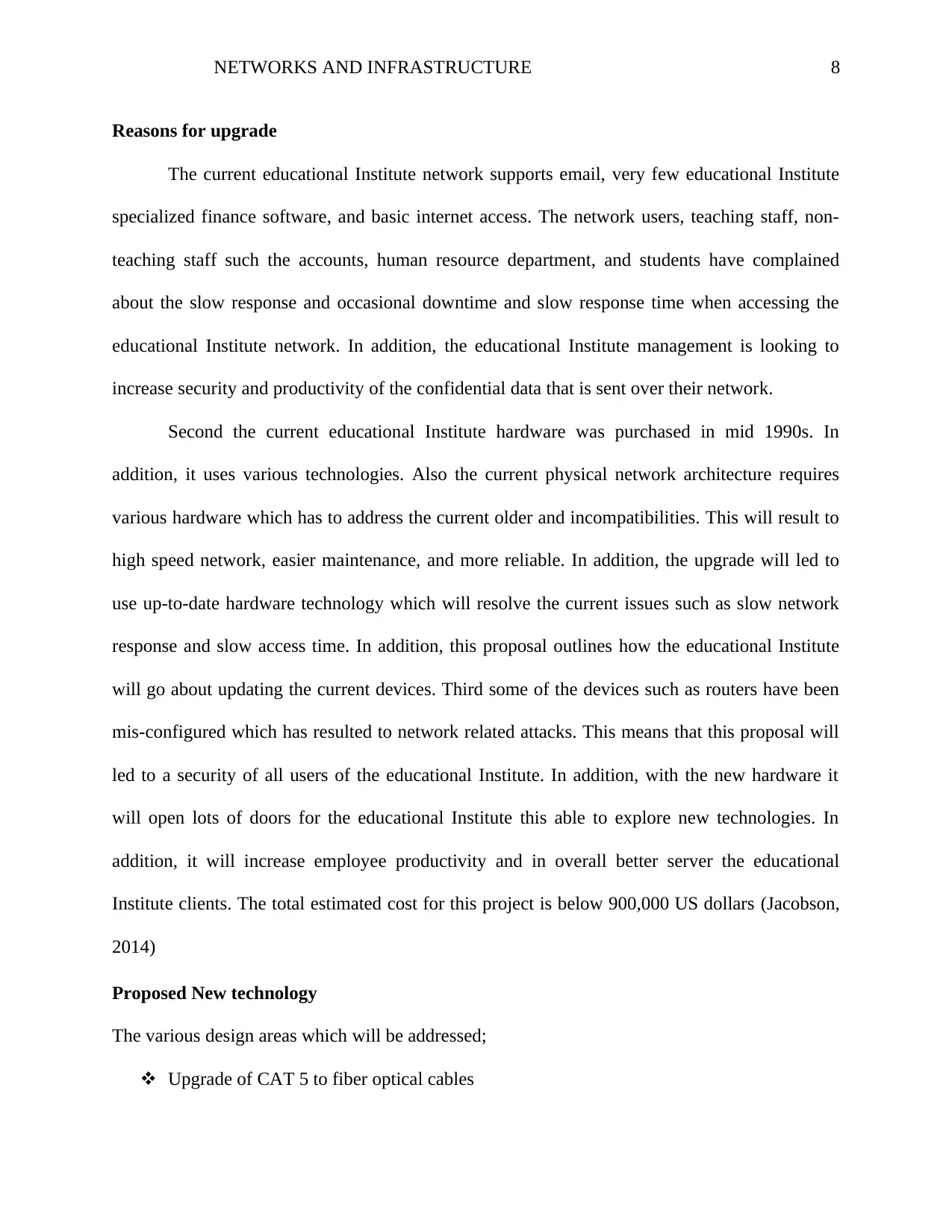
NETWORKS AND INFRASTRUCTURE 8
Reasons for upgrade
The current educational Institute network supports email, very few educational Institute
specialized finance software, and basic internet access. The network users, teaching staff, non-
teaching staff such the accounts, human resource department, and students have complained
about the slow response and occasional downtime and slow response time when accessing the
educational Institute network. In addition, the educational Institute management is looking to
increase security and productivity of the confidential data that is sent over their network.
Second the current educational Institute hardware was purchased in mid 1990s. In
addition, it uses various technologies. Also the current physical network architecture requires
various hardware which has to address the current older and incompatibilities. This will result to
high speed network, easier maintenance, and more reliable. In addition, the upgrade will led to
use up-to-date hardware technology which will resolve the current issues such as slow network
response and slow access time. In addition, this proposal outlines how the educational Institute
will go about updating the current devices. Third some of the devices such as routers have been
mis-configured which has resulted to network related attacks. This means that this proposal will
led to a security of all users of the educational Institute. In addition, with the new hardware it
will open lots of doors for the educational Institute this able to explore new technologies. In
addition, it will increase employee productivity and in overall better server the educational
Institute clients. The total estimated cost for this project is below 900,000 US dollars (Jacobson,
2014)
Proposed New technology
The various design areas which will be addressed;
Upgrade of CAT 5 to fiber optical cables
Reasons for upgrade
The current educational Institute network supports email, very few educational Institute
specialized finance software, and basic internet access. The network users, teaching staff, non-
teaching staff such the accounts, human resource department, and students have complained
about the slow response and occasional downtime and slow response time when accessing the
educational Institute network. In addition, the educational Institute management is looking to
increase security and productivity of the confidential data that is sent over their network.
Second the current educational Institute hardware was purchased in mid 1990s. In
addition, it uses various technologies. Also the current physical network architecture requires
various hardware which has to address the current older and incompatibilities. This will result to
high speed network, easier maintenance, and more reliable. In addition, the upgrade will led to
use up-to-date hardware technology which will resolve the current issues such as slow network
response and slow access time. In addition, this proposal outlines how the educational Institute
will go about updating the current devices. Third some of the devices such as routers have been
mis-configured which has resulted to network related attacks. This means that this proposal will
led to a security of all users of the educational Institute. In addition, with the new hardware it
will open lots of doors for the educational Institute this able to explore new technologies. In
addition, it will increase employee productivity and in overall better server the educational
Institute clients. The total estimated cost for this project is below 900,000 US dollars (Jacobson,
2014)
Proposed New technology
The various design areas which will be addressed;
Upgrade of CAT 5 to fiber optical cables
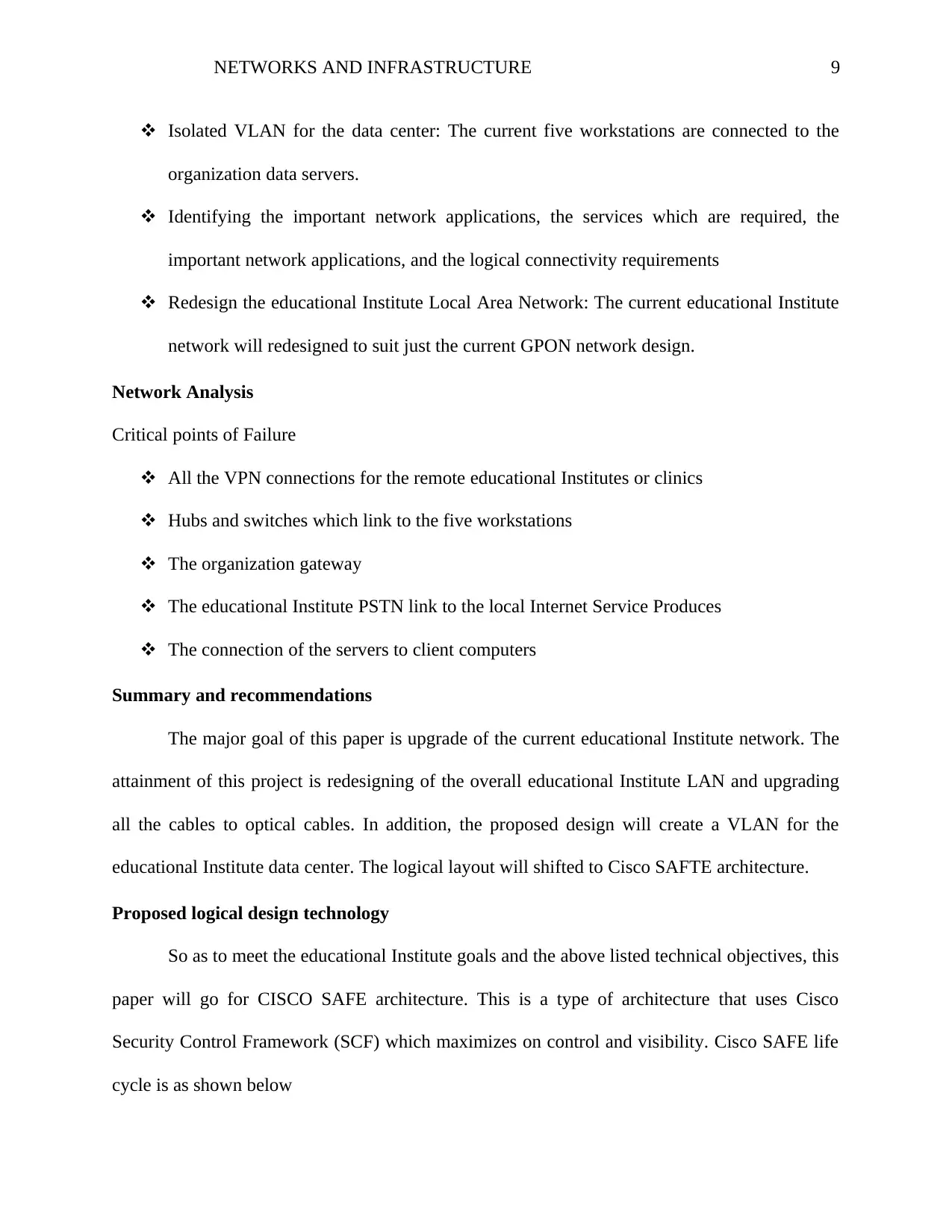
NETWORKS AND INFRASTRUCTURE 9
Isolated VLAN for the data center: The current five workstations are connected to the
organization data servers.
Identifying the important network applications, the services which are required, the
important network applications, and the logical connectivity requirements
Redesign the educational Institute Local Area Network: The current educational Institute
network will redesigned to suit just the current GPON network design.
Network Analysis
Critical points of Failure
All the VPN connections for the remote educational Institutes or clinics
Hubs and switches which link to the five workstations
The organization gateway
The educational Institute PSTN link to the local Internet Service Produces
The connection of the servers to client computers
Summary and recommendations
The major goal of this paper is upgrade of the current educational Institute network. The
attainment of this project is redesigning of the overall educational Institute LAN and upgrading
all the cables to optical cables. In addition, the proposed design will create a VLAN for the
educational Institute data center. The logical layout will shifted to Cisco SAFTE architecture.
Proposed logical design technology
So as to meet the educational Institute goals and the above listed technical objectives, this
paper will go for CISCO SAFE architecture. This is a type of architecture that uses Cisco
Security Control Framework (SCF) which maximizes on control and visibility. Cisco SAFE life
cycle is as shown below
Isolated VLAN for the data center: The current five workstations are connected to the
organization data servers.
Identifying the important network applications, the services which are required, the
important network applications, and the logical connectivity requirements
Redesign the educational Institute Local Area Network: The current educational Institute
network will redesigned to suit just the current GPON network design.
Network Analysis
Critical points of Failure
All the VPN connections for the remote educational Institutes or clinics
Hubs and switches which link to the five workstations
The organization gateway
The educational Institute PSTN link to the local Internet Service Produces
The connection of the servers to client computers
Summary and recommendations
The major goal of this paper is upgrade of the current educational Institute network. The
attainment of this project is redesigning of the overall educational Institute LAN and upgrading
all the cables to optical cables. In addition, the proposed design will create a VLAN for the
educational Institute data center. The logical layout will shifted to Cisco SAFTE architecture.
Proposed logical design technology
So as to meet the educational Institute goals and the above listed technical objectives, this
paper will go for CISCO SAFE architecture. This is a type of architecture that uses Cisco
Security Control Framework (SCF) which maximizes on control and visibility. Cisco SAFE life
cycle is as shown below
⊘ This is a preview!⊘
Do you want full access?
Subscribe today to unlock all pages.

Trusted by 1+ million students worldwide
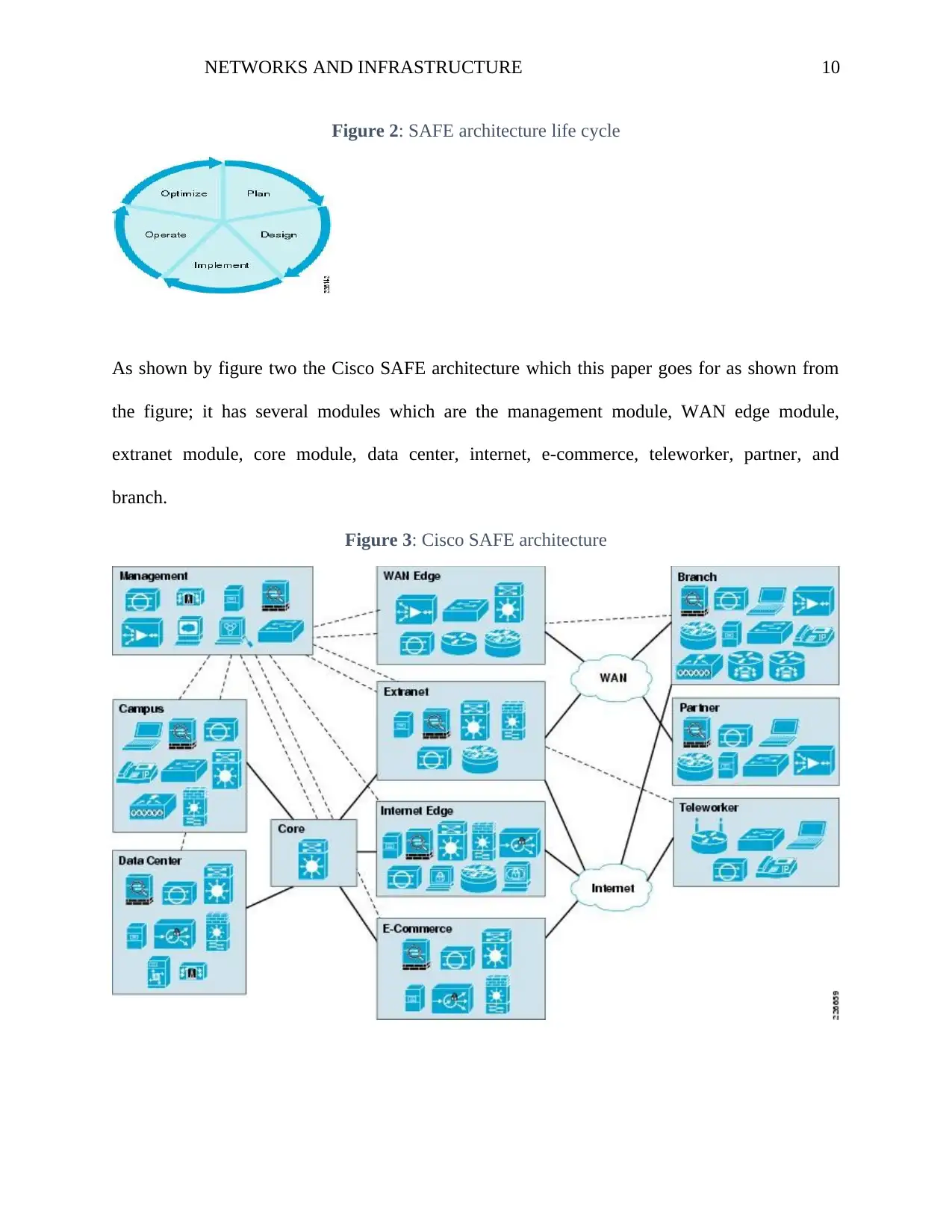
NETWORKS AND INFRASTRUCTURE 10
Figure 2: SAFE architecture life cycle
As shown by figure two the Cisco SAFE architecture which this paper goes for as shown from
the figure; it has several modules which are the management module, WAN edge module,
extranet module, core module, data center, internet, e-commerce, teleworker, partner, and
branch.
Figure 3: Cisco SAFE architecture
Figure 2: SAFE architecture life cycle
As shown by figure two the Cisco SAFE architecture which this paper goes for as shown from
the figure; it has several modules which are the management module, WAN edge module,
extranet module, core module, data center, internet, e-commerce, teleworker, partner, and
branch.
Figure 3: Cisco SAFE architecture
Paraphrase This Document
Need a fresh take? Get an instant paraphrase of this document with our AI Paraphraser
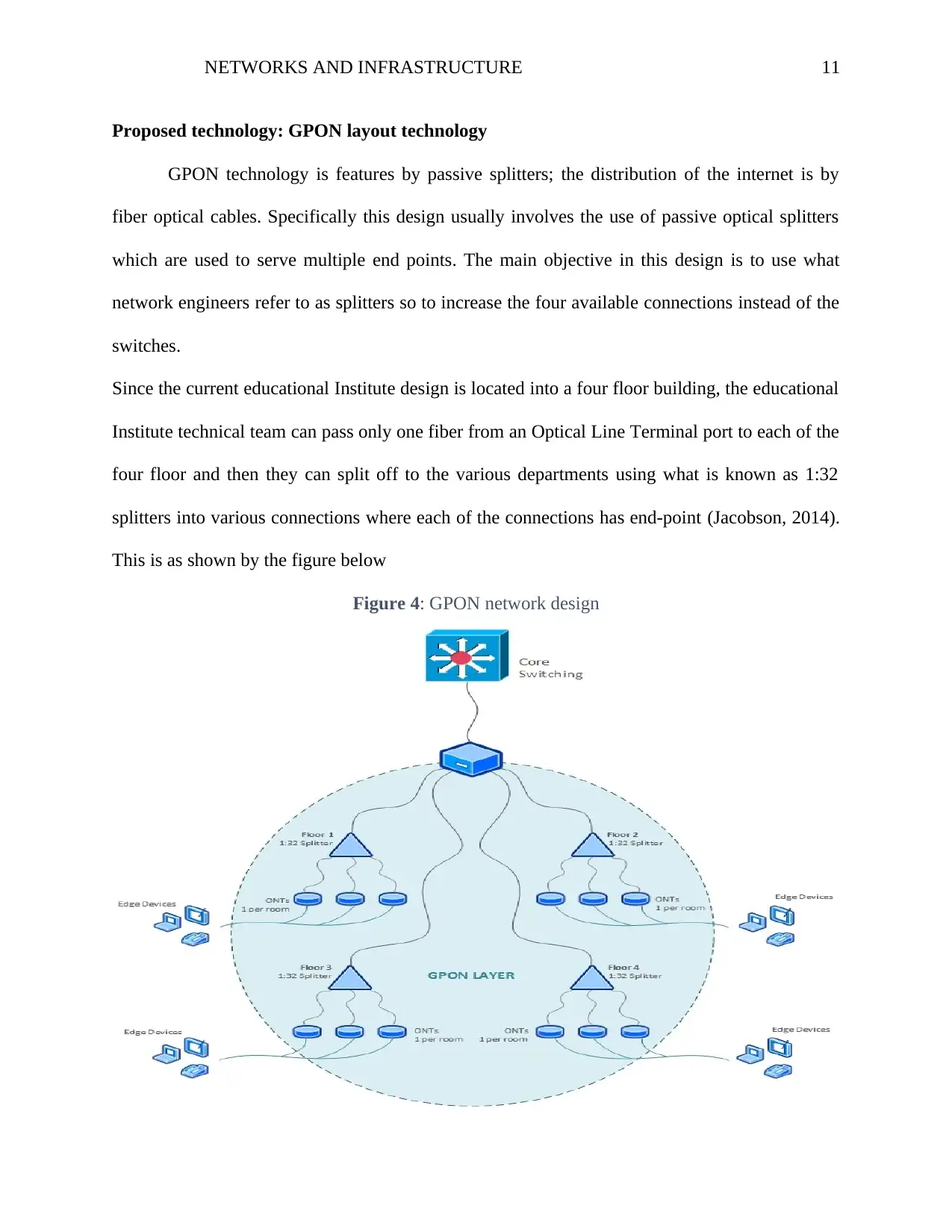
NETWORKS AND INFRASTRUCTURE 11
Proposed technology: GPON layout technology
GPON technology is features by passive splitters; the distribution of the internet is by
fiber optical cables. Specifically this design usually involves the use of passive optical splitters
which are used to serve multiple end points. The main objective in this design is to use what
network engineers refer to as splitters so to increase the four available connections instead of the
switches.
Since the current educational Institute design is located into a four floor building, the educational
Institute technical team can pass only one fiber from an Optical Line Terminal port to each of the
four floor and then they can split off to the various departments using what is known as 1:32
splitters into various connections where each of the connections has end-point (Jacobson, 2014).
This is as shown by the figure below
Figure 4: GPON network design
Proposed technology: GPON layout technology
GPON technology is features by passive splitters; the distribution of the internet is by
fiber optical cables. Specifically this design usually involves the use of passive optical splitters
which are used to serve multiple end points. The main objective in this design is to use what
network engineers refer to as splitters so to increase the four available connections instead of the
switches.
Since the current educational Institute design is located into a four floor building, the educational
Institute technical team can pass only one fiber from an Optical Line Terminal port to each of the
four floor and then they can split off to the various departments using what is known as 1:32
splitters into various connections where each of the connections has end-point (Jacobson, 2014).
This is as shown by the figure below
Figure 4: GPON network design
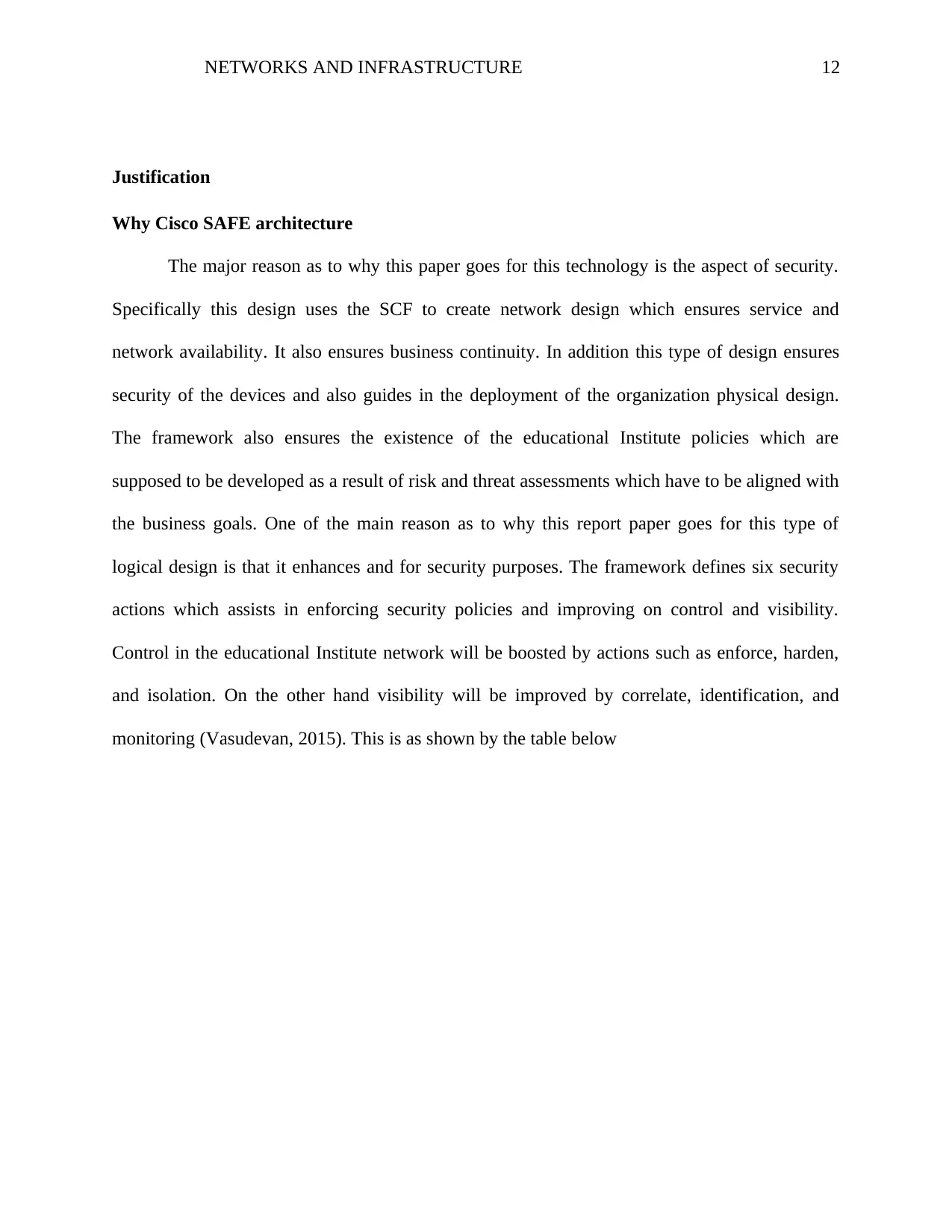
NETWORKS AND INFRASTRUCTURE 12
Justification
Why Cisco SAFE architecture
The major reason as to why this paper goes for this technology is the aspect of security.
Specifically this design uses the SCF to create network design which ensures service and
network availability. It also ensures business continuity. In addition this type of design ensures
security of the devices and also guides in the deployment of the organization physical design.
The framework also ensures the existence of the educational Institute policies which are
supposed to be developed as a result of risk and threat assessments which have to be aligned with
the business goals. One of the main reason as to why this report paper goes for this type of
logical design is that it enhances and for security purposes. The framework defines six security
actions which assists in enforcing security policies and improving on control and visibility.
Control in the educational Institute network will be boosted by actions such as enforce, harden,
and isolation. On the other hand visibility will be improved by correlate, identification, and
monitoring (Vasudevan, 2015). This is as shown by the table below
Justification
Why Cisco SAFE architecture
The major reason as to why this paper goes for this technology is the aspect of security.
Specifically this design uses the SCF to create network design which ensures service and
network availability. It also ensures business continuity. In addition this type of design ensures
security of the devices and also guides in the deployment of the organization physical design.
The framework also ensures the existence of the educational Institute policies which are
supposed to be developed as a result of risk and threat assessments which have to be aligned with
the business goals. One of the main reason as to why this report paper goes for this type of
logical design is that it enhances and for security purposes. The framework defines six security
actions which assists in enforcing security policies and improving on control and visibility.
Control in the educational Institute network will be boosted by actions such as enforce, harden,
and isolation. On the other hand visibility will be improved by correlate, identification, and
monitoring (Vasudevan, 2015). This is as shown by the table below
⊘ This is a preview!⊘
Do you want full access?
Subscribe today to unlock all pages.

Trusted by 1+ million students worldwide
1 out of 26
Related Documents
Your All-in-One AI-Powered Toolkit for Academic Success.
+13062052269
info@desklib.com
Available 24*7 on WhatsApp / Email
![[object Object]](/_next/static/media/star-bottom.7253800d.svg)
Unlock your academic potential
Copyright © 2020–2025 A2Z Services. All Rights Reserved. Developed and managed by ZUCOL.





